Thermal Properties of Hemp Shives Used as Insulation Material in Construction Industry
Abstract
:1. Introduction
2. Possible Applications of Shives in Construction Industry
3. Materials and Methods
3.1. Hemp Shives
3.2. Methods of Testing the Properties of Hemp Shives
3.2.1. Pore Size Distribution
3.2.2. Thermal Conductivity
3.2.3. Air Permeability
4. Results and Discussion
4.1. Pore Size Distribution
4.2. Thermal Conductivity
4.3. Air Permeability
4.4. An Impact of Convection on Heat Transfer through Hemp Shives Insulation
5. Thermal Simulation
5.1. Preprocessing
5.2. Model Description
5.3. Simulation Results and Discussion
6. Conclusions
- Thermal conductivity 0.049–0.052 W/(m·K), measured in the density range of 109–124 kg/m3, shows a little tendency to rise with density. The density of 109 kg/m3 was the minimum value that could be achieved with this test.
- Air permeability in the range of 4.259744 × 10−8–1.832226 × 10−9 m2, measured in the density range of 90–120 kg/m3, shows a decreasing tendency with increasing density. The density of 90 kg/m3 was the minimum value that could be achieved with this test.
- The porosity tests showed that the individual elements of the hemp shives have a porosity of more than 78%. The largest share, i.e., about 40%, corresponds to the pores with a diameter in the range of 0.9–3 μm.
- The results of the Rayleigh number calculation show that along with the rising density of shives, the share of convection will be limited. However, the results of the simulations indicate that in order to minimize the heat losses caused by convection, the thermal insulation made of shives should be covered with air-tight membranes.
- In the case of insulation with lower density, the increase in heat flux occurs more rapidly after air filtration begins. An increase in the pressure difference enhances the rate of changes. The maximum value of heat flux is reached after a longer time, the thicker the insulation is.
- Larger temperature drops on the inner surface of the wall, due to the air pressure were observed in the wall with shives of lower density.
Author Contributions
Funding
Institutional Review Board Statement
Informed Consent Statement
Data Availability Statement
Conflicts of Interest
References
- Van der Werf, H.M.G. Life cycle analysis of field production of fibre hemp, the effect of production practices on environmental impacts. Euphytica 2004, 140, 13–23. [Google Scholar] [CrossRef]
- DEFRA. UK Flax and Hemp Production: The Impact of Changes in Support Measures on the Competitiveness and Future Potential of UK Fibre Production and Industrial Use; Department for Environment Food and Rural Affairs: London, UK, 2005.
- Ip, K.; Miller, A. Life cycle greenhouse gas emissions of hemp-lime wall constructions in the UK. Resour. Conserv. Recycl. 2012, 69, 1–9. [Google Scholar] [CrossRef]
- Zampori, L.; Dotelli, G.; Vernelli, V. Life cycle assessment of hemp cultivation and use of hemp-based thermal insulator materials in buildings. Environ. Sci. Technol. 2013, 47, 7413–7420. [Google Scholar] [CrossRef]
- Boutin, M.-P.; Flamin, C.; Quinton, S.; Gosse, G. Analyse du cycle de vie de mur en béton chanvre banché sur ossature en bois (Life Cycle Analysis of A Cast Hemp-Lime Timber Framed Wall); INRA: Lille, France, 2005. [Google Scholar]
- Lawrence, M.; Fodde, E.; Paine, K.; Walker, P. Hygrothermal performance of an experimental hemp-lime building. Key Eng. Mater. 2012, 517, 413–421. [Google Scholar] [CrossRef] [Green Version]
- Pervaiz, M.; Sain, M.M. Carbon storage potential in natural fiber composites. Resour. Conserv. Recycl. 2003, 39, 325–340. [Google Scholar] [CrossRef]
- International Energy Agency (IEA). SHC Task 40/ECBCS Annex 52 towards Net-Zero Energy Solar Buildings 2013 Highlights. 2013. Available online: http://task40.iea-shc.org/data/sites/1/publications/Task40-Highlights-2013.pdf (accessed on 17 May 2018).
- Allin, S. Building with Hemp; Seed Press: Kenmare, Ireland, 2012. [Google Scholar]
- Brzyski, P.; Kosiński, P.; Zgliczyńska, A.; Iwanicki, P.; Poko, J. Mass Transport and Thermal Conductivity Properties of Flax Shives for Use in Construction Industry. J. Nat. Fibers 2021, 18, 995–1006. [Google Scholar] [CrossRef]
- Kosiński, P.; Brzyski, P.; Suchorab, Z.; Łagód, G. Heat Losses Caused by the Temporary Influence of Wind in Timber Frame Walls Insulated with Fibrous Materials. Materials 2020, 13, 5514. [Google Scholar] [CrossRef]
- Balčiūnas, G.; Vėjelis, S.; Lekūnaitė, L.; Kremensas, A. Assessment of structure influence on thermal conductivity of hemp shives composite. Environ. Eng. Manag. J. 2016, 15, 699–705. [Google Scholar] [CrossRef]
- Bourdot, A.; Moussa, T.; Gacoin, A.; Maalouf, C.; Vazquez, P.; Thomachot-Schneider, C.; Bliard, C.; Merabtine, A.; Lachi, M.; Douzane, O.; et al. Laboratory Characterization of a hemp-based agro-material: Influence of starch ratio and hemp shive size on physical, mechanical, and hygrothermal properties. Energy Build. 2017, 153, 501–512. [Google Scholar] [CrossRef]
- Rahim, M.; Douzane, O.; Tran Le, A.D.; Promis, G.; Laidoudi, B.; Crigny, A.; Dupre, B.; Langlet, T. Characterization of flax lime and hemp lime concretes: Hygric properties and moisture buffer capacity. Energy Build. 2015, 88, 91–99. [Google Scholar] [CrossRef]
- Collet, F.; Chamoin, J.; Pretot, S.; Lanos, C. Comparison of the hygric behaviour of three hemp concretes. Energy Build. 2013, 62, 294–303. [Google Scholar] [CrossRef]
- Jiang, Y.; Ansell, M.; Jia, X.; Hussain, A.; Lawrence, M. Physical characterisation of hemp shiv: Cell wall structure and porosity. In Proceedings of the 2nd International Conference on Bio-Based Building Materials, Clermont-Ferrand, France, 21–23 June 2017. [Google Scholar]
- Nguyen, T.; Picandet, V.; Amziane, S.; Baley, C. Influence of compactness and hemp hurd characteristics on the mechanical properties of lime and hemp concrete. Eur. J. Environ. Civ. Eng. 2009, 13, 1039–1050. [Google Scholar] [CrossRef]
- Sinka, S.; Sahmenko, G.; Korjakins, A.; Bajare, D. Lime-hemp concrete (LHC) enhancement using magnesium based binders. Acad. J. Civ. Eng. 2017, 35, 238–245. [Google Scholar] [CrossRef]
- Sinka, S.; Sahmenko, G.; Korjakins, A.; Radina, L.; Bajare, D. Hemp Thermal Insulation Concrete with Alternative Binders, Analysis of their Thermal and Mechanical Properties. IOP Conf. Ser. Mater. Sci. Eng. 2015, 96, 012029. [Google Scholar] [CrossRef]
- Dinh, T.M.; Magniont, C.; Coutand, M.; Escadeillas, G. Hemp concrete using innovative pozzolanic binder. Acad. J. Civ. Eng. 2015, 33, 265–270. [Google Scholar]
- Cerezo, V. Propriétés Mécaniques, Thermiques et Acoustiques d’un Matériau à Base de Particules Végétales: Approche Expérimentale et Modélisation Théorique. Ph.D. Thesis, National School of State Public Works, Vaulx-en-Velin, France, 2005. [Google Scholar]
- Magniont, C. Contribution à la Formulation et à la Caractérisation d’un écomatériau de Construction à Base d’Agroressources. Ph.D. Thesis, Université de Toulouse, Toulouse, France, 2010. [Google Scholar]
- Verdier, T. Valorisation de granulats végétaux dans un matériau de construction à matrice minérale. Master’s Thesis, Université de Toulouse, Toulouse, France, 2012. [Google Scholar]
- Brzyski, P.; Gleń, P.; Gładecki, M.; Rumińska, M.; Suchorab, Z.; Łagód, G. Influence of the Direction of Mixture Compaction on the Selected Properties of a Hemp-Lime Composite. Materials 2021, 14, 4629. [Google Scholar] [CrossRef]
- Arnaud, L.; Gourlay, E. Experimental study of parameters influencing mechanical properties of hemp concretes. Constr. Build. Mater. 2012, 28, 50–56. [Google Scholar] [CrossRef]
- Benfratello, S.; Capitano, C.; Peri, G.; Rizzo, G.; Scaccianoce, G.; Sorrentino, G. Thermal and structural properties of a hemp–lime biocomposite. Constr. Build. Mater. 2013, 48, 745–754. [Google Scholar] [CrossRef]
- Walker, R.; Pavía, S. Moisture transfer and thermal properties of hemp–lime concretes. Constr. Build. Mater. 2014, 64, 270–276. [Google Scholar] [CrossRef]
- Stevulova, N.; Kidalova, L.; Cigasova, J.; Junak, J.; Sicakova, A.; Terpakova, E. Lightweight Composites Containing Hemp Hurds. Proced. Eng. 2013, 65, 69–74. [Google Scholar] [CrossRef] [Green Version]
- Walker, R.; Pavía, S.; Mitchell, R. Mechanical properties and durability of hemp-lime concretes. Constr. Build. Mater. 2014, 61, 340–348. [Google Scholar] [CrossRef]
- Barclay, M.; Holcroft, N.; Shea, A.D. Methods to determine whole building hygrothermal performance of hempelime buildings. Build. Environ. 2014, 80, 204–212. [Google Scholar] [CrossRef] [Green Version]
- Tran Le, A.; Maalouf, C.; Mai, T.H.; Wurtz, E.; Collet, F. Transient hygrothermal behaviour of a hemp concrete building envelope. Energy Build. 2010, 42, 1797–1806. [Google Scholar] [CrossRef]
- Brzyski, P.; Gładecki, M.; Rumińska, M.; Pietrak, K.; Kubiś, M.; Łapka, P. Influence of Hemp Shives Size on Hygro-Thermal and Mechanical Properties of a Hemp-Lime Composite. Materials 2020, 13, 5383. [Google Scholar] [CrossRef]
- Iștoan, R.F.; Manea, D.L.; Tamas-Gavrea, D.R.; Rosca, I.C. Hemp-clay building materials—An investigation on acoustic, thermal and mechanical properties. Procedia Manuf. 2019, 32, 216–223. [Google Scholar] [CrossRef]
- Hamzaoui, R.; Guessasma, S.; Abahri, K. Mechanical performance of mortars modified with hemp fibres, shives and milled fly ashes. In Proceedings of the 2nd International RILEM/COST Conference on Early Age Cracking and Serviceability in Cement-Based Materials and Structures—EAC2, ULB-VUB, Brussels, Belgium, 12–14 September 2017. [Google Scholar]
- Mostefai, N.; Hamzaoui, R.; Guessasma, S.; Aw, A.; Nouri, H. Microstructure and mechanical performance of modified hemp fibre and shiv mortars: Discovering the optimal formulation. Mater. Des. 2015, 84, 359–371. [Google Scholar] [CrossRef]
- Hamzaoui, R.; Guessasma, S.; Abahri, K.; Bouchenafa, O. Formulation of Modified Cement Mortars Using Optimal Combination of Fly Ashes, Shiv, and Hemp Fibers. J. Mater. Civ. Eng. 2020, 32, 04019354. [Google Scholar] [CrossRef]
- Jiang, Y.; Lawrence, M.; Ansell, M.P.; Hussain, A. Cell wall microstructure, pore size distribution and absolute density of hemp shiv. R. Soc. Open Sci. 2018, 5, 4. [Google Scholar] [CrossRef] [Green Version]
- Shen, X.; Jiang, P.; Guo, D.; Li, G.; Chu, F.; Yang, S. Effect of Furfurylation on Hierarchical Porous Structure of Poplar Wood. Polymers 2021, 13, 32. [Google Scholar] [CrossRef]
- Zhao, J.; Yang, L.; Cai, Y. Combining mercury intrusion porosimetry and fractal theory to determine the porous characteristics of wood. Wood Sci. Technol. 2021, 55, 109–124. [Google Scholar] [CrossRef]
- Wójcik, R.; Tunkiewicz, M. Ink-bottle pores–characteristics, methods of determination on the basis of lime–cements mortar. Mater. Bud. 2017, 10, 59–61. (In Polish) [Google Scholar] [CrossRef]
- EN 12667: Thermal Performance of Building Materials and Products—Determination of Thermal Resistance by Means of Guarded Hot Plate and Heat Flow Meter Methods—Products of High and Medium Thermal Resistance. Available online: https://standards.iteh.ai/catalog/standards/sist/c479b508-30f0-4315-aa53-ce8f39252a5f/sist-en-12667-2002 (accessed on 11 February 2022).
- Kosiński, P.; Wójcik, R. An Impact of Air Permeability on Heat Transfer through Partitions Insulated with Loose Fiber Materials. Appl. Mech. Mater. 2017, 861, 190–197. [Google Scholar] [CrossRef]
- Zach, J.; Slávik, R.; Novák, V. Investigation of the Process of Heat Transfer in the Structure of Thermal Insulation Materials Based on Natural Fibres. Procedia Eng. 2016, 151, 352–359. [Google Scholar] [CrossRef] [Green Version]
- Delhomme, F.; Hajimohammadi, A.; Almeida, A.; Jiang, C.; Moreau, D.; Gan, Y.; Wang, X.; Castel, A. Physical properties of Australian hurd used as aggregate for hemp concrete. Mater. Today Commun. 2020, 24, 100986. [Google Scholar] [CrossRef]
- Brzyski, P.; Kosiński, P.; Skoratko, A.; Motacki, W. Thermal properties of cellulose fiber as insulation material in a loose state. AIP Conf. Proc. 2019, 2133, 020006. [Google Scholar] [CrossRef]
- Kosiński, P.; Brzyski, P.; Szewczyk, A.; Motacki, W. Thermal properties of raw hemp fiber as a loose-fill insulation material. J. Nat. Fib. 2018, 15, 717–730. [Google Scholar] [CrossRef]
- Kosiński, P.; Wójcik, R.; Skoratko, D.; Attia, S. An impact of moisture content on the air permeability of the fibrous insulation materials. J. Phys. Conf. Ser. 2021, 2069, 012205. [Google Scholar] [CrossRef]
- Csanády, D.; Fenyvesi, O.; Nagy, B. Heat Transfer in Straw-Based Thermal Insulating Materials. Materials 2021, 14, 4408. [Google Scholar] [CrossRef]
- ISO 10456; Building Materials and Products—Hygrothermal Properties—Tabulated Design Values and Procedures for Determining Declared and Design Thermal Values. British Standards: London, UK, 2008.
- Kosiński, P.; Wójcik, R.; Semen, B. Experimental study on the deterioration of thermal insulation performance due to wind washing of the cavity insulation in leaky walls. Sci. Technol. Built Environ. 2019, 25, 1164–1177. [Google Scholar] [CrossRef]

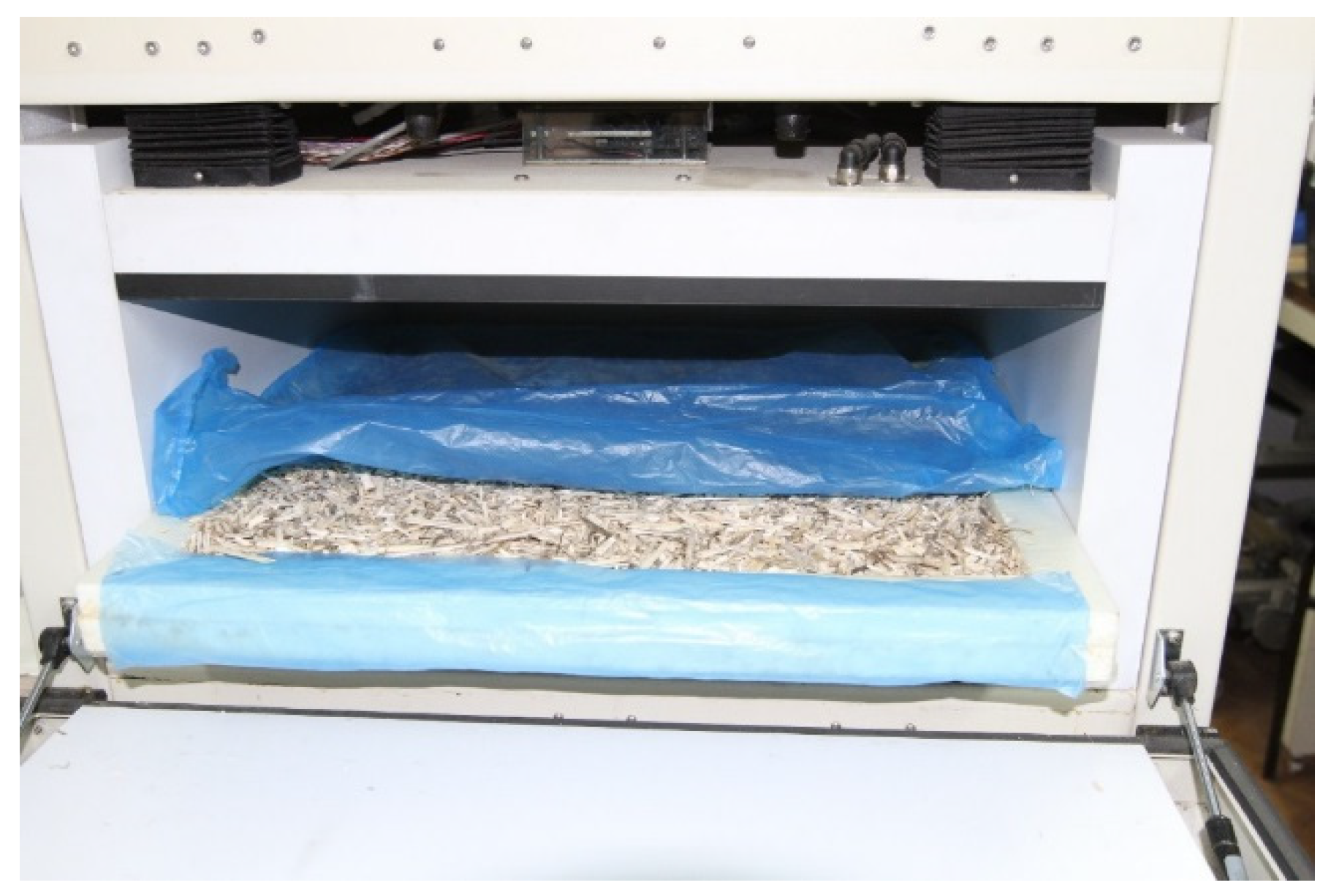

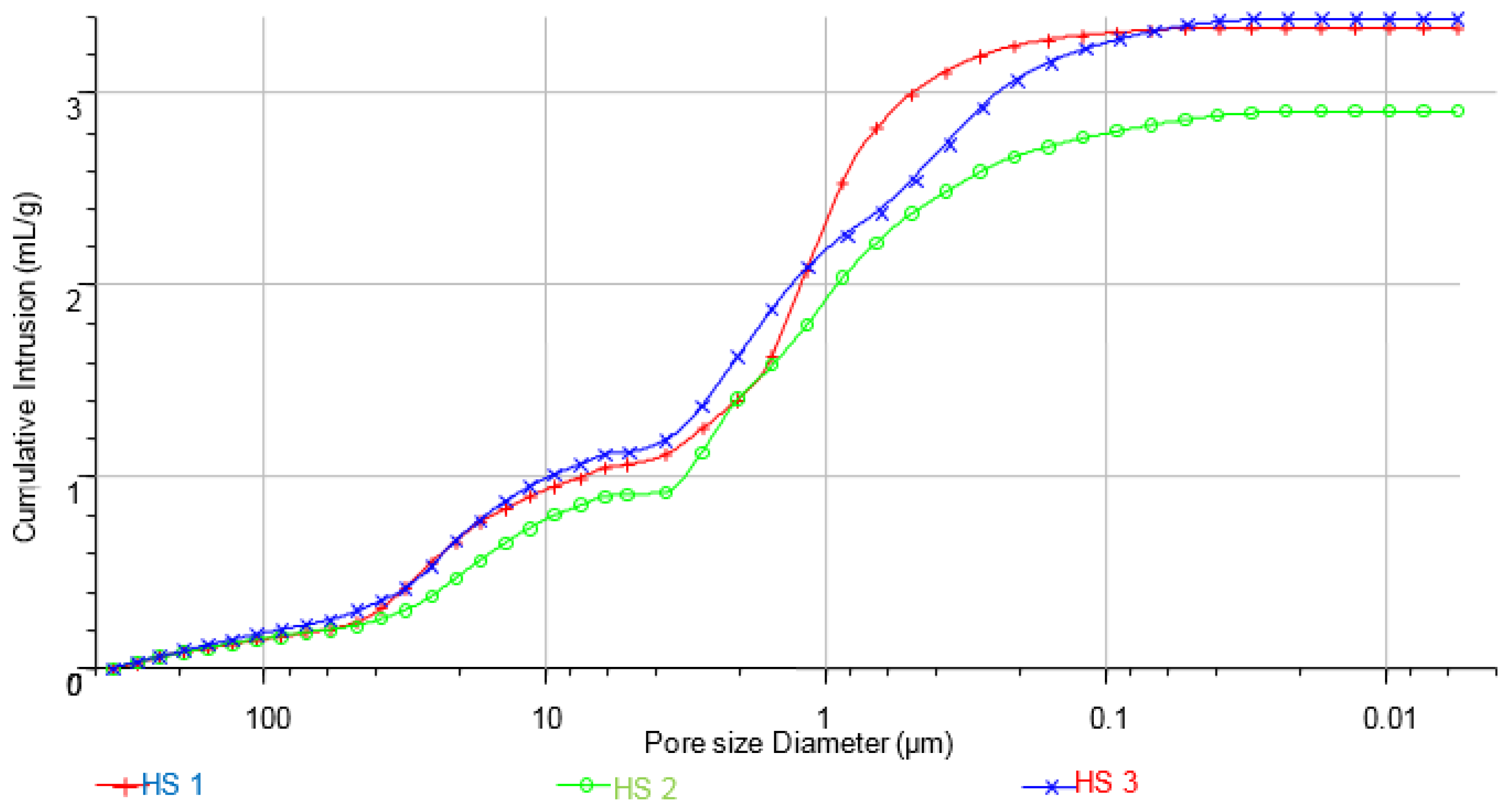
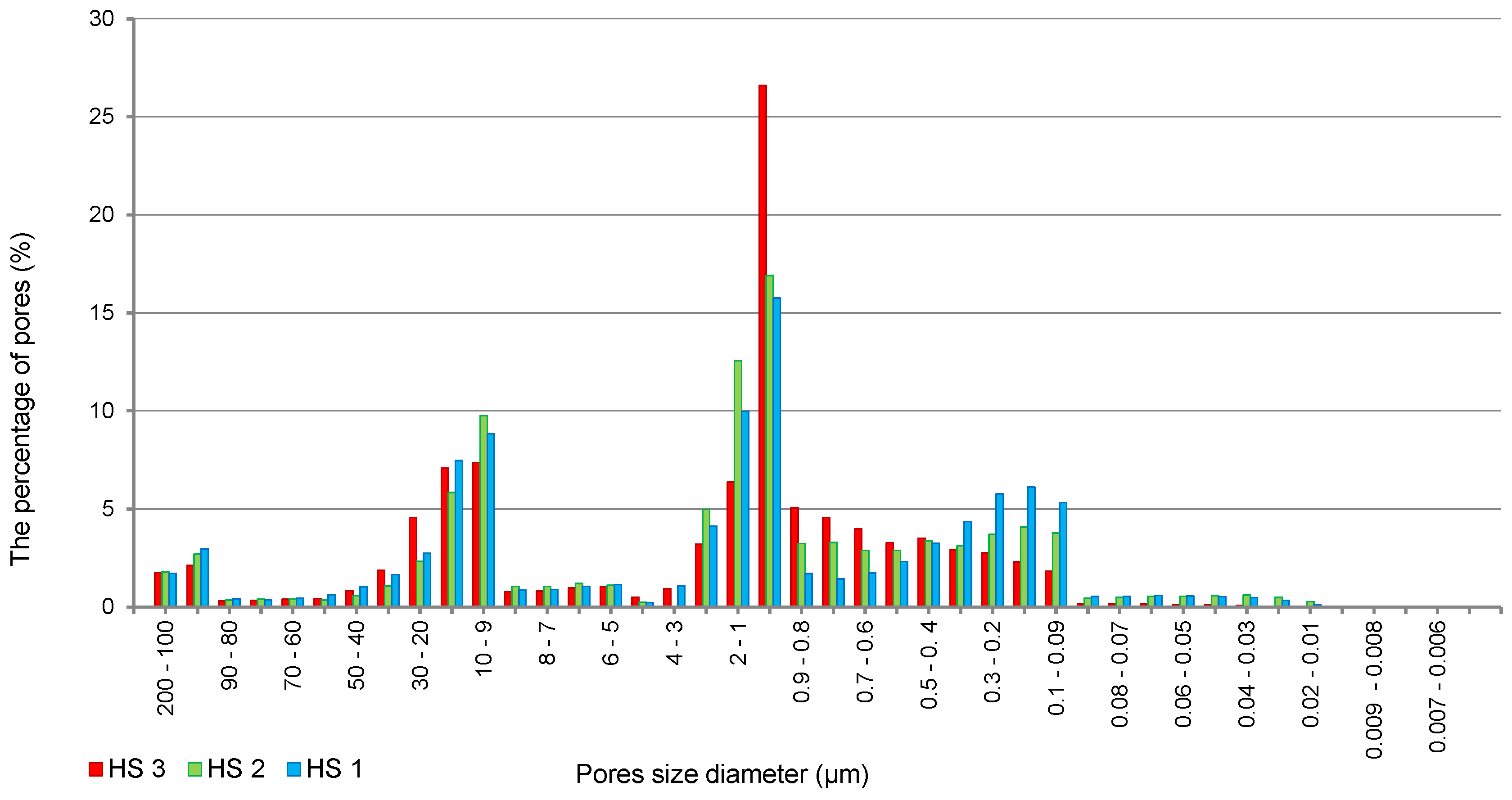

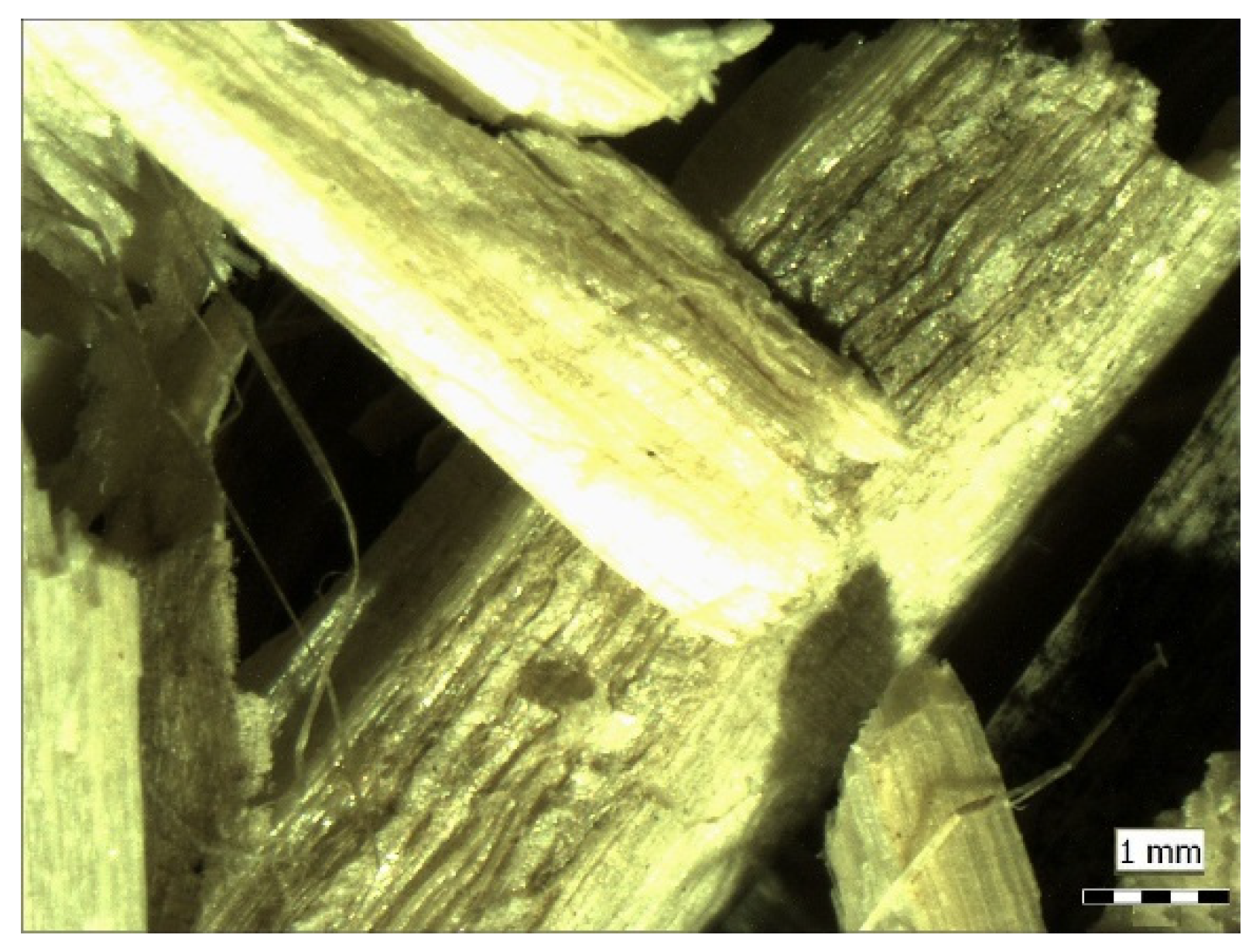



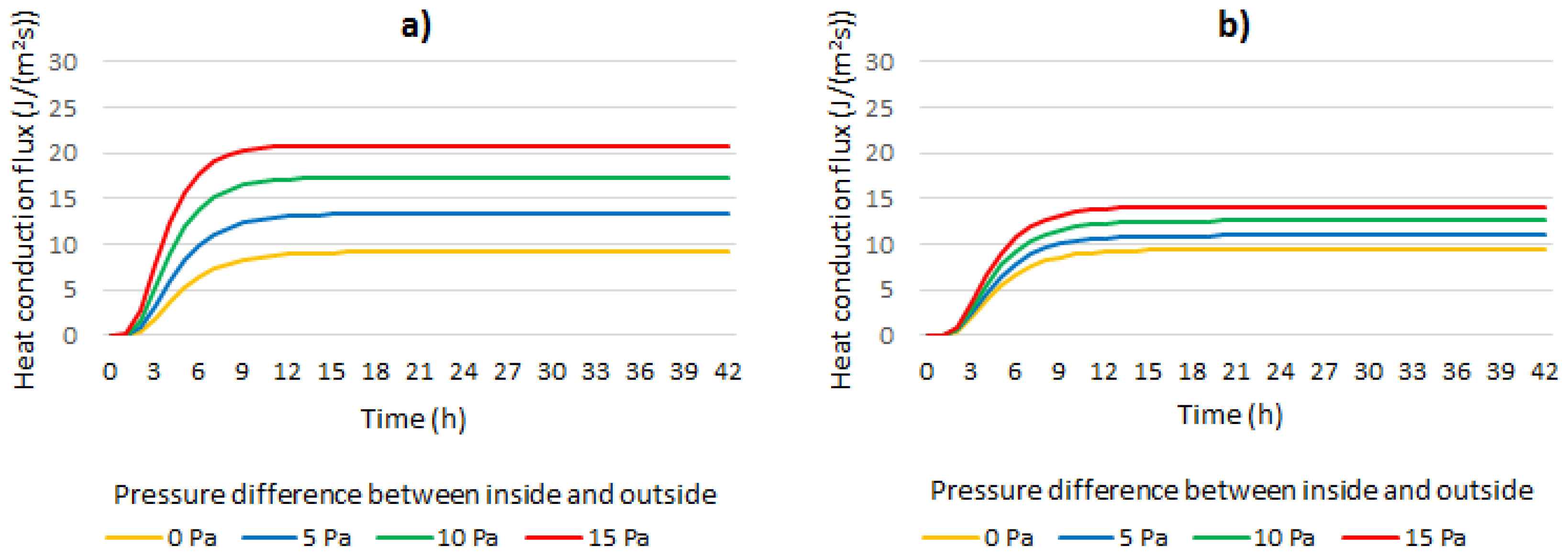
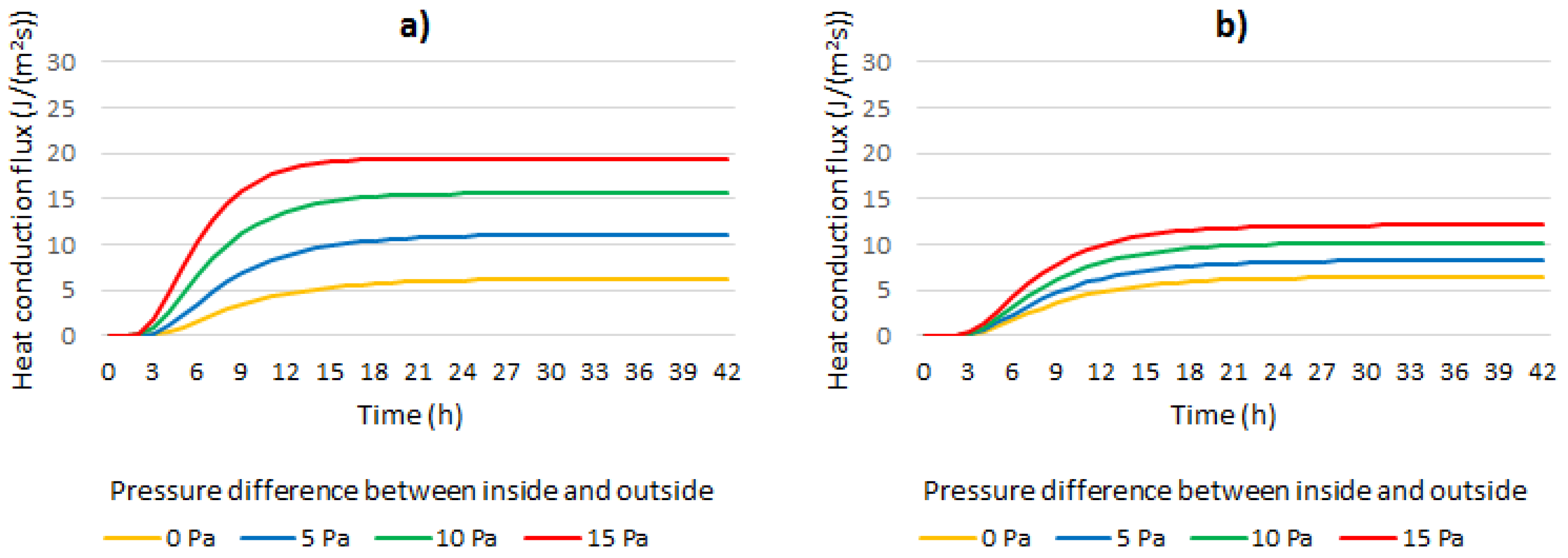
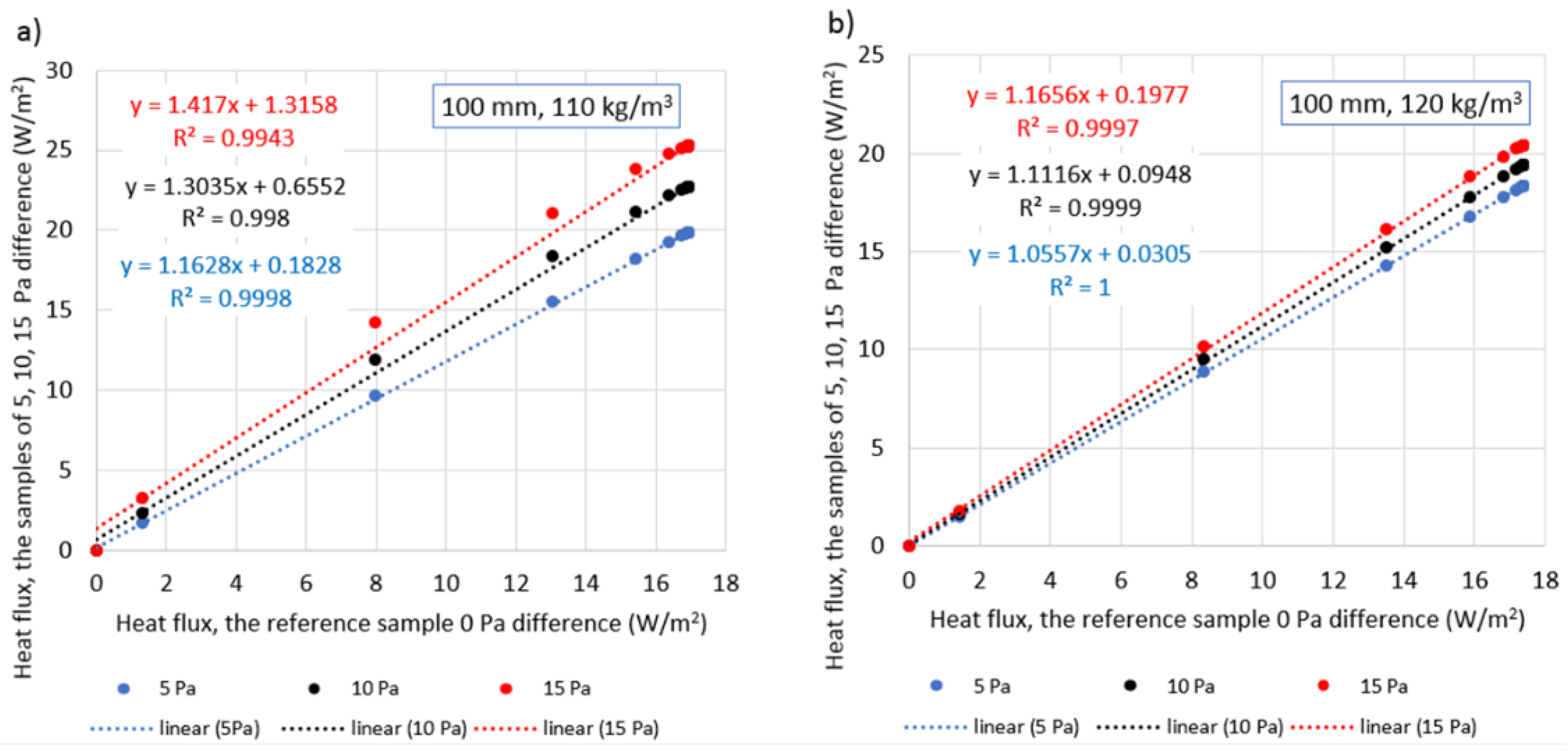
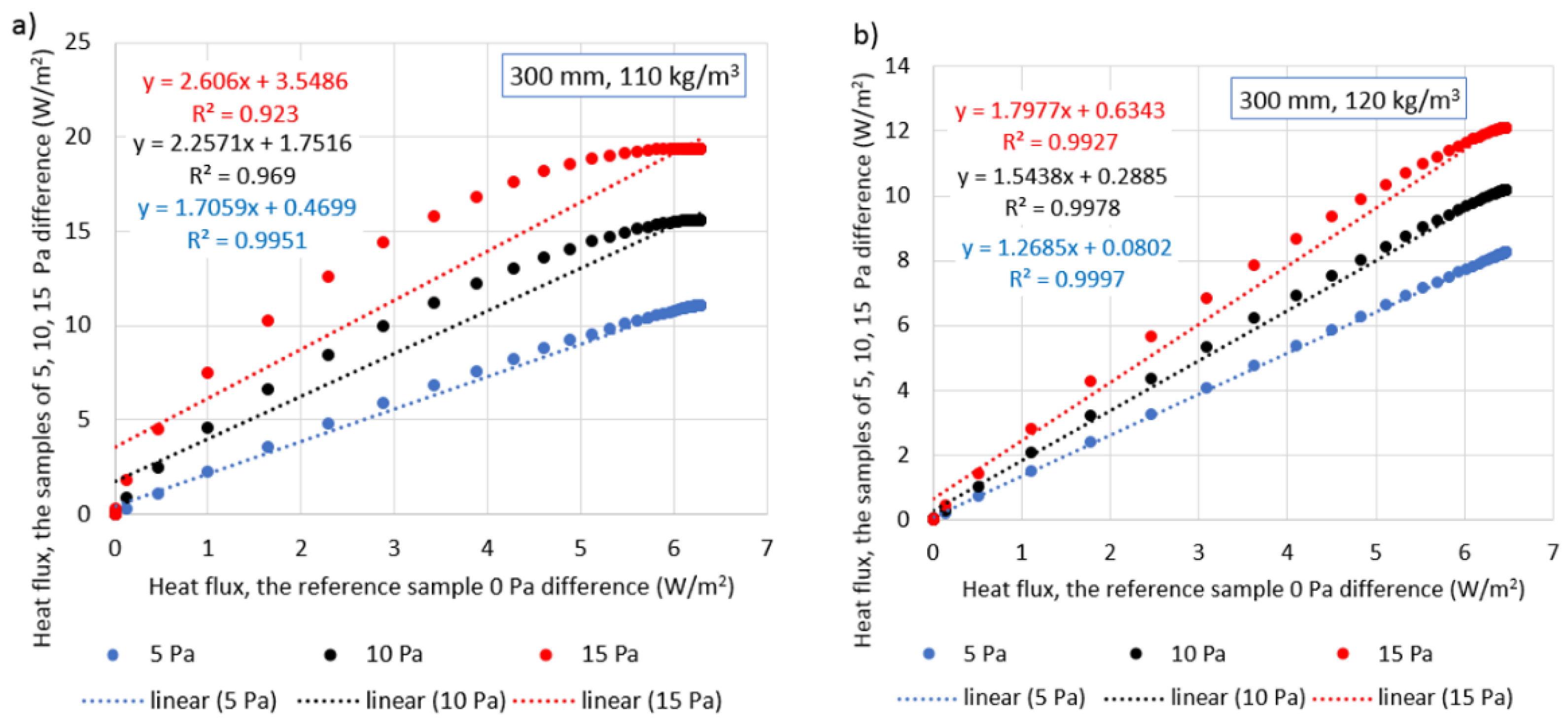
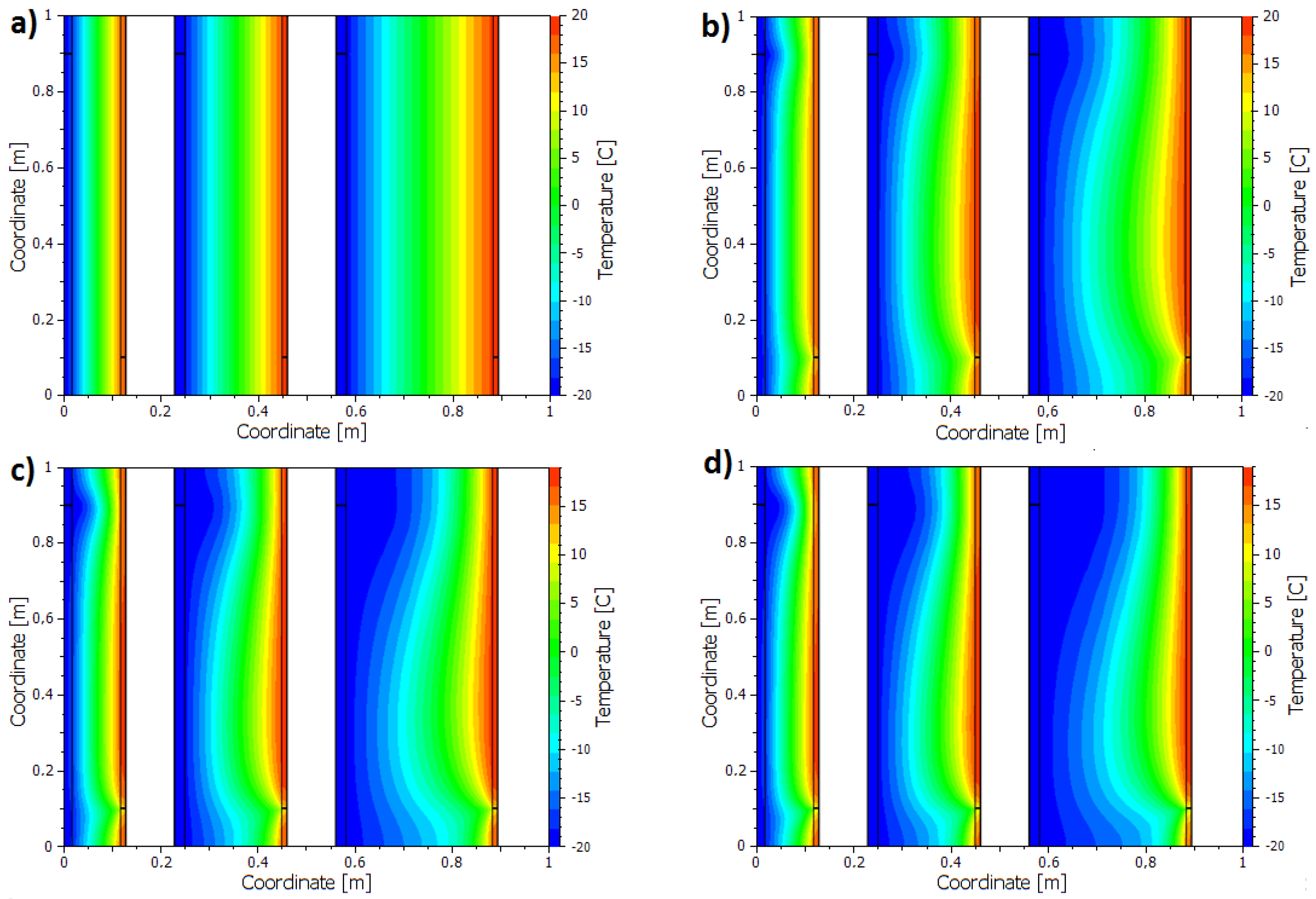
| Hemp Shives Type/Property | HS1 | HS2 | HS3 | Unit |
|---|---|---|---|---|
| Total Intrusion Volume | 3.34 | 2.9132 | 3.3908 | mL/g |
| Total Pore Area | 13.586 | 21.309 | 24.948 | m²/g |
| Median Pore Diameter (Volume) | 1476.4 | 1897.1 | 1889.1 | nm |
| Bulk Density | 0.2406 | 0.2625 | 0.2338 | g/mL |
| Porosity | 80.346 | 76.4842 | 79.269 | % |
| Bulk Density (kg/m3) | Thermal Conductivity Coefficient (W/(m·K)) | Literature |
|---|---|---|
| 72.3 | 0.052 | [19] |
| 111.8 | 0.058 | [20] |
| 108.4 | 0.058 | [18] |
| 110.0 | 0.048 | [21] |
| 155.0 | 0.058 | [21] |
| 134.8 | 0.055 | [22] |
| 148.3 | 0.056 | [23] |
| Bulk Density of Hemp Shives (kg/m3) | Measured Maximum Pressure Difference On the Length of Specimen (Pa) | Measured Maximum Air Velocity in the Outlet of Apparatus (m/s) | Calculated Air Permeability Coefficient (m2) |
|---|---|---|---|
| 90 | 726 | 0.4 | 4.259744 × 10−8 |
| 95 | 802 | 0.37 | 2.184845 × 10−8 |
| 100 | 810 | 0.31 | 1.507439 × 10−8 |
| 105 | 926 | 0.3 | 9.252043 × 10−9 |
| 110 | 976 | 0.26 | 6.621214 × 10−9 |
| 115 | 979 | 0.23 | 2.223948 × 10−9 |
| 120 | 981 | 0.22 | 1.832226 × 10−9 |
| Material | d (m) | λ (W/(m·K) | κ (m2) |
|---|---|---|---|
| Gypsum board | 0.012 | 0.2000 | - |
| OSB board | 0.02 | 0.1300 | - |
| Hemp shives 110 kg/m3 | 0.1; 0.2; 0.3 | 0.0513 | 6.621 × 10−9 |
| Hemp shives 120 kg/m3 | 0.1; 0.2; 0.3 | 0.0498 | 1.832 × 10−9 |
Publisher’s Note: MDPI stays neutral with regard to jurisdictional claims in published maps and institutional affiliations. |
© 2022 by the authors. Licensee MDPI, Basel, Switzerland. This article is an open access article distributed under the terms and conditions of the Creative Commons Attribution (CC BY) license (https://creativecommons.org/licenses/by/4.0/).
Share and Cite
Kosiński, P.; Brzyski, P.; Tunkiewicz, M.; Suchorab, Z.; Wiśniewski, D.; Palczyński, P. Thermal Properties of Hemp Shives Used as Insulation Material in Construction Industry. Energies 2022, 15, 2461. https://doi.org/10.3390/en15072461
Kosiński P, Brzyski P, Tunkiewicz M, Suchorab Z, Wiśniewski D, Palczyński P. Thermal Properties of Hemp Shives Used as Insulation Material in Construction Industry. Energies. 2022; 15(7):2461. https://doi.org/10.3390/en15072461
Chicago/Turabian StyleKosiński, Piotr, Przemysław Brzyski, Maria Tunkiewicz, Zbigniew Suchorab, Damian Wiśniewski, and Paweł Palczyński. 2022. "Thermal Properties of Hemp Shives Used as Insulation Material in Construction Industry" Energies 15, no. 7: 2461. https://doi.org/10.3390/en15072461
APA StyleKosiński, P., Brzyski, P., Tunkiewicz, M., Suchorab, Z., Wiśniewski, D., & Palczyński, P. (2022). Thermal Properties of Hemp Shives Used as Insulation Material in Construction Industry. Energies, 15(7), 2461. https://doi.org/10.3390/en15072461









